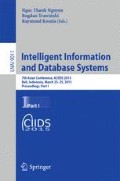Abstract
Current bitemporal data models use valid time and transaction time to indicate the time that a fact is valid in a domain, and the time that the fact is stored in a database respectively. In order to store historical data with different beliefs during the same valid time period, there need to be a time dimension which indicates the belief time; the time that the fact is believed to be true. This belief time is different from the conventional transaction time, which is the time that the fact is entered into the database. In this paper, a belief-based approach to bitemporal data model is presented together with its query and manipulation considerations.
Access this chapter
Tax calculation will be finalised at checkout
Purchases are for personal use only
Preview
Unable to display preview. Download preview PDF.
References
Carvalho, A., Ribeiro, C., Sousa, A.A.: A spatio-temporal database system based on TimeDB and Oracle spatial. In: Tjoa, A.M., Xu, L., Chaudhry, S.S. (eds.) Research and Practical Issues of Enterprise Information Systems. IFIP, vol. 205, pp. 11–20. Springer, Boston (2006)
Date, C.J., Darwen, H., Lorentzos, N.A.: Temporal Data and The Relational Model. Morgan Kaufmann Publishers, California (2002)
Snodgrass, R.T.: Developing Time-Oriented Database Applications in SQL. Morgan Kaufmann Publishers, California (2000)
Jensen, C.S., Snodgrass, R.T.: Temporal Data Management. IEEE Transactions on Knowledge and Data Engineering 11, 36–44 (1999)
Sarda, N.L., Reddy, P.V.S.P.: Handling of Alternatives and Events in Temporal Databases. Knowledge and Information Systems 1, 337–368 (1999)
Papadakis, N., Antoniou, G., Plexousakis, D.: The ramification problem in temporal databases: Changing beliefs about the past. Data Knowledge Engineering 59, 397–424 (2006)
Gadia, S.K.: Applicability of temporal data models to query multilevel security databases: a case study. In: Etzion, O., Jajodia, S., Sripada, S. (eds.) Temporal Databases - Research and Practice. LNCS, vol. 1399, pp. 238–256. Springer, Heidelberg (1998)
Author information
Authors and Affiliations
Corresponding author
Editor information
Editors and Affiliations
Rights and permissions
Copyright information
© 2015 Springer International Publishing Switzerland
About this paper
Cite this paper
Jiratanachit, W., Chittayasothorn, S. (2015). A Belief-Based Bitemporal Database Model. In: Nguyen, N., Trawiński, B., Kosala, R. (eds) Intelligent Information and Database Systems. ACIIDS 2015. Lecture Notes in Computer Science(), vol 9011. Springer, Cham. https://doi.org/10.1007/978-3-319-15702-3_17
Download citation
DOI: https://doi.org/10.1007/978-3-319-15702-3_17
Published:
Publisher Name: Springer, Cham
Print ISBN: 978-3-319-15701-6
Online ISBN: 978-3-319-15702-3
eBook Packages: Computer ScienceComputer Science (R0)

